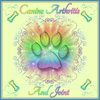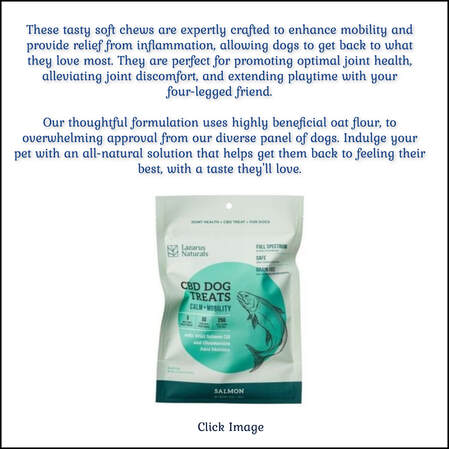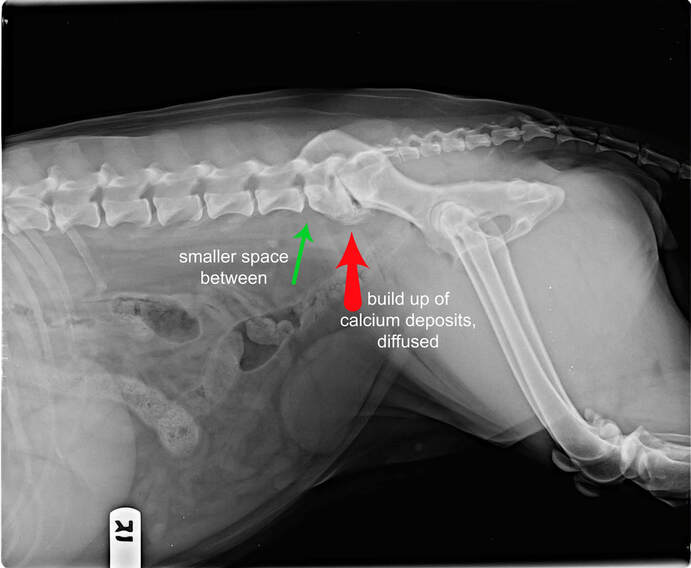|
By Vet Info Lumbosacral spondylosis is a degenerative arthritic condition of a dog’s spine. It usually develops as a dog moves into his later years, and it affects his mobility. Let’s look at the symptoms of lumbosacral spondylosis and what you and your veterinarian can do to help your dog feel better if he has this condition. Lumbosacral Spondylosis Symptoms Symptoms of lumbosacral spondylosis can range from asymptomatic (showing no symptoms) to severe disability.
The exact cause of lumbosacral spondylosis is unknown, although genetics, trauma or environmental factors may play roles in its development. Lumbosacral spondylosis affects the lower part of the dog’s spine and should not be confused with cervical spondylosis, which affects a dog’s upper spine, or thoracic spondylosis that affects the middle of a dog’s spine. It is common in large breed dogs, especially the German shepherd, in their later years. Dogs are most likely to show symptoms as the disease first develops, but they seem to adjust to the disease after an initial adjustment period. |
|
Diagnosing and Treating Lumbosacral Spondylosis
Your veterinarian may use a variety of tests to diagnose lumbosacral spondylosis in your dog. These may include a physical examination, laboratory tests and x-rays. He or she may also request a myelogram (a test of spinal compression), a force plate analysis (to determine weight tolerance) and joint fluid analysis (an examination of fluid from your dog’s joints to determine whether his problems are caused by a degenerative or infectious disease). |
|
After a diagnosis has been made, your veterinarian will formulate a treatment plan. Depending on the severity of your dog’s symptoms, treatment may include:
In severe cases, surgery may be required to relieve your dog’s pain. In most cases, your veterinarian will remove bone spurs that have formed on your dog’s spine and irritate the nerves in your dog’s back legs. Follow-up care, including physical therapy, is usually needed to help your dog make a full recovery in about six months. |
|
Additional Steps That Can Help Your Dog
Discuss your dog’s treatment plan with your veterinarian to see if additional steps can be taken to further ease your dog’s discomfort. If he’s overweight, a weight reduction and management plan may need to be part of your dog’s treatment plan because additional weight is detrimental to your dog’s overall health, and the extra weight isn’t helping his lumbosacral spondylosis, either. Implementing a daily exercise plan tailored to your dog’s situation can help manage his condition. Walking is one recommended exercise, but swimming or other water therapy can also help less-mobile dogs achieve their exercise goals. Exercise also helps your pet maintain a healthy weight. Heat therapy may be another useful part of your dog’s overall treatment plan. He may benefit from moist heat, such as the use of water bottles or warm towels wrapped around his joints to help ease his discomfort. Some dogs may also find pain relief from regular gentle massages, which can help stimulate blood flow and loosen tight muscles. ~Vetinfo |
|
To treat Spondylosis and to see much improvement using natural remedies. NO grains or carbs like potatoes should be in diet. Homemade is best. Remove all vaccines except for the 3 yr Thimerosol Free Rabies. Do not give Heartworm preventives or other medications unless ABSOLUTELY necessary. You can use other options for heartworm preventives. Use NSAIDS only as needed and not daily. Purchase a water filter that filters out chemicals, fluoride and chlorine. Look into Hydrotherapy. Some facilities for rehabbing animals may have a water treadmill or pool. If they don't, look into purchasing a small above ground pool to work with your dog yourself 2-3 times a week for 5-15 minutes would be enough. Make sure the water is warm (85-95 degrees). Work the legs so that they are swimming using the back legs. Try even walking them on the hind legs for a minute or two..off and on. Get creative on how to strengthen those leg and back muscles and work them without having the entire weight on them. Water removes that weight. If they refuse to kick those back legs, drop pool water to top of their legs and walk them around. Look into Acupuncture and Cold Laser Therapy. Also chiropractic adjustments. Give high quality preservative free joint supplements daily. You may need to give your dog the loading dose most of the time. And the best overall success I have seen is using Adequan with my dogs. I use it every 3 weeks. I also went two months twice a week of injections before my dog started to level off. Now she is pain free and has been for several years. ZERO pain medications. Daily massages are highly recommended as well and focus on the spine for blood flow. Add in recommended supplements also. And short walks daily or every other day are very beneficial as well. You should keep the body moving. Moist cold and/or heat packs for 15-20 minutes up to 3 times a day on those not so good days helps. Lots of options that work. So be patient. Give pain meds prescribed by your vet if needed until you get these things in action and supplements added. It may take a few weeks but once you start seeing improvement, reduce NSAIDS slowly and hopefully you can get completely off of them. NSAIDS work against joints. It actually breaks down the joint cartilage and causes more long term issues including kidney and liver disease and/or failure. ~ C.A.J.
|
**Canine Arthritis And Joint is intended for informational, educational and entertainment purposes only and is not a substitute for medical advice, diagnosis or treatment. Do not attempt to self-diagnose or treat any health condition. You should always consult with a healthcare professional before starting any diet, exercise or supplementation program, before taking any medication, or if you have or suspect your pet might have a health problem. The opinions expressed by Canine Arthritis And Joint are not to be replaced for medical care. This website and the information contained herein have not been evaluated by the Food and Drug Administration. The information and opinions on Canine Arthritis And Joint are not intended and cannot be used to diagnose, treat, cure, or prevent any disease. This applies to people and pets!
This site uses affiliate links such as banners you may see that allows for paid commissions.
This site uses affiliate links such as banners you may see that allows for paid commissions.
Canine Arthritis And Joint © Copyright 2015-2024
Designed By Paw Prints Web Design
Designed By Paw Prints Web Design












